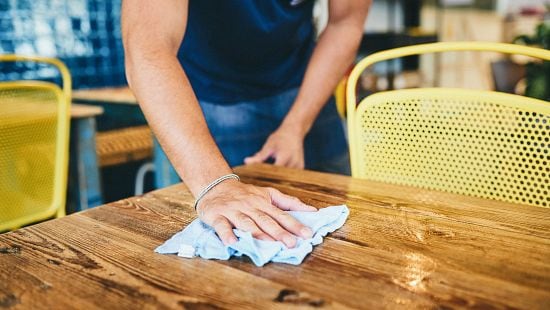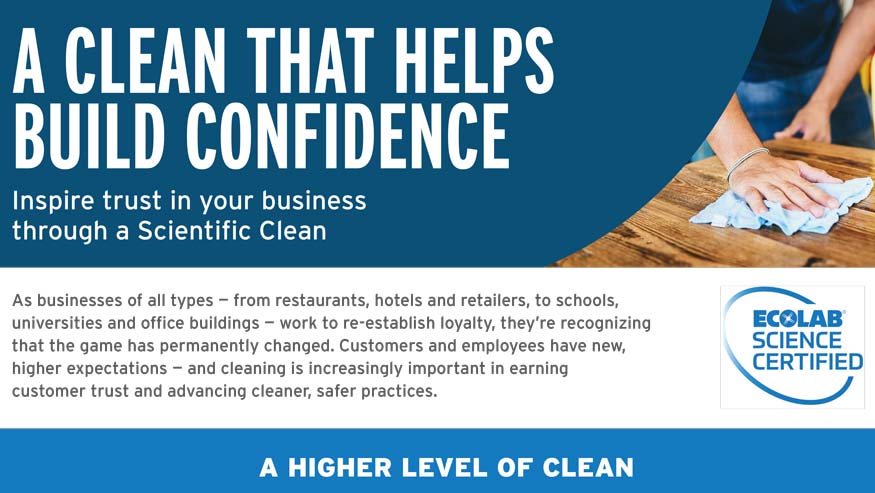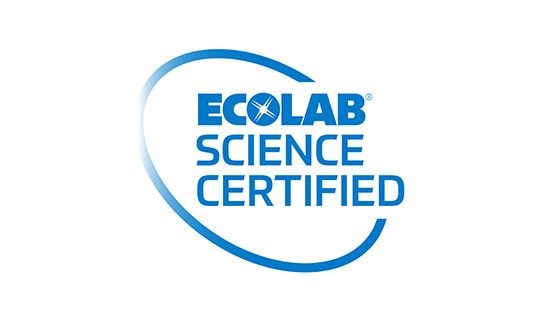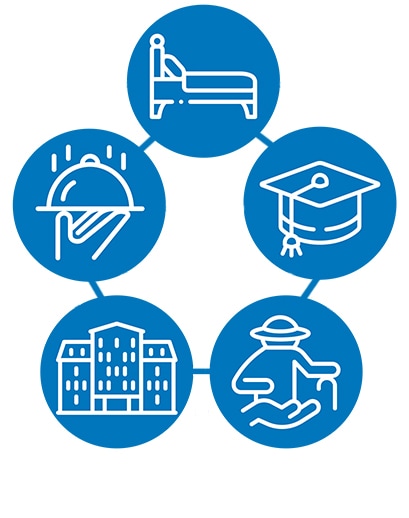Making the Shift: Cleaning for Confidence vs. Cleaning for Appearance
Four key considerations for inspiring confidence in the cleanliness of your business

Businesses of all types — from restaurants, hotels, and retailers, to schools, universities, and commercial offices — are quickly adjusting to today’s new landscape. But this adjustment isn’t just a matter of addressing evolving restrictions as eager patrons make decisions on where to eat, stay, shop and play.
Infection prevention and food safety have always been important to us, but many of today’s consumers have new expectations compared to a year or two ago. Their awareness is heightened and their confidence is harder to earn (and keep) — and the cleanliness and safety of spaces plays a much bigger role in shaping their perceptions.1 Every business with public foot traffic needs to focus on inspiring confidence in those entering its spaces, and this requires a bit of a paradigm shift: from cleaning for appearance to cleaning for confidence.
Heightened awareness for public health risks of all types
Our collective awareness of public health risks lurking in everyday places increased over the past year. An Ernst & Young consumer survey found that 7 in 10 people say they’re more aware of hygiene and sanitation in businesses.2 That awareness goes well beyond the most recent pandemic; we all know more about how pathogens like influenza, norovirus, MRSA and even rhinoviruses that cause the common cold can be spread within enclosed spaces.
In turn, expectations for facility cleanliness are higher. Organizations of all types stepped up hygiene protocols in the past year, and Ecolab research shows consumers want to see as much or more cleaning and disinfection continuing even after the vaccine is widely distributed.3

Infographic Download: Ecolab Science Certified™ Clean with Confidence
Download this PDF for the four key considerations that can help deliver a confident clean for your business.
Cleaning to build customer confidence
For most organizations, cleanliness has traditionally been more focused on the perception of clean - visual and olfactory cues that signal to patrons that the space is well taken care of. Does the space look clean? Does it smell clean? These indicators have served organizations — and the people entering them — as reliable (often subconscious) cues to the cleanliness and safety of an operation.
But today, we all know more than ever that looks can be deceiving when it comes to cleanliness. Businesses — as well as consumers — have become increasingly literate in overall environmental hygiene. One of the biggest lessons we’ll all take away from the last year is that cleaning for today’s consumer is increasingly important.
As organizations make a permanent shift to cleaning for health and safety, here are four key considerations:
- Achieving a Scientific Clean.
Clean can have many meanings. But achieving a level of clean that helps your customers and your employees feel confident means going beyond simply the aesthetic elements of cleaning to helping consistently kill pathogens like influenza, norovirus, and SARS-CoV-2. Partnering with a cleaning company with deep subject matter expertise in environmental hygiene will help confirm you’ve implemented a robust and comprehensive cleaning program built with science-backed products and procedures to drive, gain, and keep customer confidence.
- Start with cleaning best practices and consistent procedures.
Using antimicrobials won’t automatically create cleaner, healthier spaces. You need to confirm your team is following the directions for use on the product label to help ensure effectiveness in addition to using products on the surfaces for which it was formulated (i.e., hard or non-porous vs. soft/upholstered surfaces, food contact vs. non-food contact surfaces, etc.).
Furthermore, it is important to understand the differences between disinfectants and sanitizers. Many disinfectants both clean and disinfect in one-step. Sanitizers, however, won’t work effectively if you don’t properly clean and remove surface soils before applying. In fact, it is a requirement of the Food Code (and EPA) that surfaces are pre-cleaned before they are sanitized.
Partner with your chemical supplier to educate and train your team on best practices to help deliver consistent results, drive operational efficiency and delight your guests.
- Consider a program with an independent audit.
Given the complexity of building a comprehensive cleaning-for-confidence program, more businesses are leveraging independent audits. These programs bring in experts to verify products, like disinfectants and sanitizers, are being used properly and help encourage and equip teams with proper procedures, particularly those critical to public health and food safety outcomes.
Perhaps the greatest benefit is the powerful public confidence provided by an independent audit. Customers trust the expertise of credible cleaning partners and public health experts — and 2 in 3 consumers say they want businesses to “prove” their commitment to health and safety through an independent audit.4
- Showcase your clean spaces and proof of your commitment to clean.
The danger of pathogenic organisms is that they are microscopic, much too small to see with the human eye. Similarly, even if you do follow proper cleaning procedures, your customers can’t see that all pathogens have been killed. So how do you inspire confidence? The truth is that appearances are still critical. First impressions on how a space looks and smells will drive confidence — and 85% of people say it’s important that they see visible signs of cleaning.5
The good news is that following best practices for cleaning-for-confidence will naturally produce spaces that look and smell exceptionally clean. But you can go a step further by proactively communicating all that you’re doing to clean for confidence — through signage in your spaces and even digital marketing efforts.
Cleaning for confidence drives wide-ranging business value
The reality is that cleaning for confidence may present a shift in staff priorities and your overall operations, but it’s a worthwhile investment as heightened customer expectations are here to stay. In fact, 95% of consumers say they’ll still want to see as much — or even more — cleaning and sanitation post-vaccine.6 And as Deloitte warns, cleaning for confidence is a “make it or break it” challenge: “it either leads to increased trust or no trust at all.”7
Moreover, cleaning with public health in mind is a worthy investment that delivers business value in several other ways too. Prioritizing staff health and wellness can help reduce the costs of absenteeism, enhance staff satisfaction, improve retention, and mitigate the high costs of turnover.8 Cleaning for confidence helps enhance your brand and build your reputation. Experts agree that businesses are primarily competing based on customer experience today — and less on products or prices.9 People are increasingly seeking out value-driven organizations that align with their principles.10 A clear commitment to advancing cleaner, safer practices is a powerful way to deliver a stand-out experience, while also showing that your organization values responsible business practices, promoting the wellness of your staff and guests, and helping to build a cleaner, safer future for all.

Earning the Seal
Businesses that implement the program requirements – including public health, food safety and pest elimination solutions and employee training – and pass the Ecolab Science Certified audit earn the ability to use the Ecolab Science Certified seal.
Interested in becoming Ecolab Science Certified?
Footnotes
1https://www.deloittedigital.com/content/dam/deloittedigital/us/documents/offerings/offering-20200626-safety-cleanliness-covid.pdf
2https://www.ey.com/en_gl/consumer-products-retail/how-to-serve-the-anxious-consumer-after-covid-19
3“Post-Vaccine Consumer Attitude Study,” January 5, 2021 (paid for by Ecolab)
4“Post-Vaccine Consumer Attitude Study,” January 5, 2021 (paid for by Ecolab)
5https://www.deloittedigital.com/content/dam/deloittedigital/us/documents/offerings/offering-20200626-safety-cleanliness-covid.pdf
6“Post-Vaccine Consumer Attitude Study,” January 5, 2021 (paid for by Ecolab)
7https://www.deloittedigital.com/content/dam/deloittedigital/us/documents/offerings/offering-20200626-safety-cleanliness-covid.pdf
8https://www.uhc.com/employer/news/small-business/-new-survey--employees-say-wellness-programs-improve-health--pro
9https://www.forbes.com/sites/shephyken/2018/07/15/customer-experience-is-the-new-brand/?sh=3b7a368d7f52
10https://www.accenture.com/_acnmedia/PDF-117/Accenture-Generation-P-urpose-PoV.pdf#zoom=40



